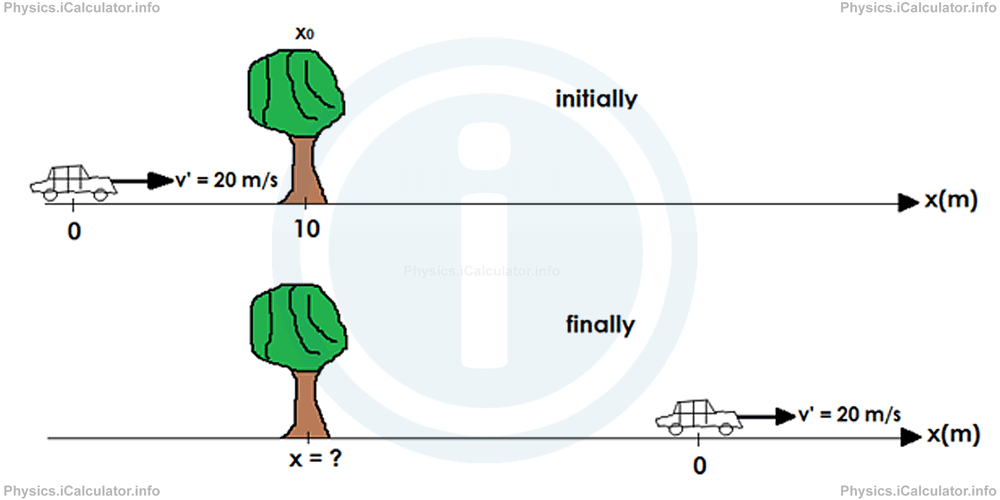Menu
Physics Lesson 3.13.3 - Case 2 - Reference frame is moving at constant velocity and the object is at rest
Please provide a rating, it takes seconds and helps us to keep this resource free for all to use
Welcome to our Physics lesson on Case 2 - Reference frame is moving at constant velocity and the object is at rest, this is the third lesson of our suite of physics lessons covering the topic of Relative Motion, you can find links to the other lessons within this tutorial and access additional physics learning resources below this lesson.
Case 2 - Reference frame is moving at constant velocity v⃗' and the object is at rest
This situation is similar to the one described in the Introduction (the moving car and the sideways trees). In this case, the object's velocity is v⃗ = 0 but the reference frame's velocity is v⃗'. If the reference frame is moving let's say due right (in the positive direction), the object seems moving due left (in the negative direction), although it is at rest.
If the object is initially at x⃗0, after t seconds, it will be at
Equation 2
x⃗(t) = x⃗0 + v⃗ × t - v⃗' × t (2)Since the object is at rest (v⃗ = 0), the second term of the above equation is cancelled, so we obtain
where v⃗' is the velocity by which the reference frame is moving. Let's illustrate this point through a numerical example.
Example 1
A car is moving at 20 m/s due right as shown in the figure.

What will the position of the tree in respect to the car be after 1.5 seconds?
Solution 1
Here the car acts as a reference frame. As stated before, the tree is at rest, so v⃗ = 0. Also, the car (which acts as a reference frame) is moving past the tree (it leaves the tree behind after a while). Therefore, the car's velocity is denoted as v⃗' = 20 m/s (it is positive as the car moves due right as well). Furthermore, the initial position of the tree is x⃗0 = 10 m as the tree initially is 10 m in front of the car. Therefore, we write
At t = 1.5 s we can write for the position of the tree x⃗:
= 10 m - 30 m
= -20 m
This result means the tree is 20 m behind the car after 1.5 s of motion.
You have reach the end of Physics lesson 3.13.3 Case 2 - Reference frame is moving at constant velocity and the object is at rest. There are 7 lessons in this physics tutorial covering Relative Motion, you can access all the lessons from this tutorial below.
More Relative Motion Lessons and Learning Resources
Whats next?
Enjoy the "Case 2 - Reference frame is moving at constant velocity and the object is at rest" physics lesson? People who liked the "Relative Motion lesson found the following resources useful:
- Case Two Feedback. Helps other - Leave a rating for this case two (see below)
- Kinematics Physics tutorial: Relative Motion. Read the Relative Motion physics tutorial and build your physics knowledge of Kinematics
- Kinematics Revision Notes: Relative Motion. Print the notes so you can revise the key points covered in the physics tutorial for Relative Motion
- Kinematics Practice Questions: Relative Motion. Test and improve your knowledge of Relative Motion with example questins and answers
- Check your calculations for Kinematics questions with our excellent Kinematics calculators which contain full equations and calculations clearly displayed line by line. See the Kinematics Calculators by iCalculator™ below.
- Continuing learning kinematics - read our next physics tutorial: Motion. Types of Motion
Help others Learning Physics just like you
Please provide a rating, it takes seconds and helps us to keep this resource free for all to use
We hope you found this Physics lesson "Relative Motion" useful. If you did it would be great if you could spare the time to rate this physics lesson (simply click on the number of stars that match your assessment of this physics learning aide) and/or share on social media, this helps us identify popular tutorials and calculators and expand our free learning resources to support our users around the world have free access to expand their knowledge of physics and other disciplines.